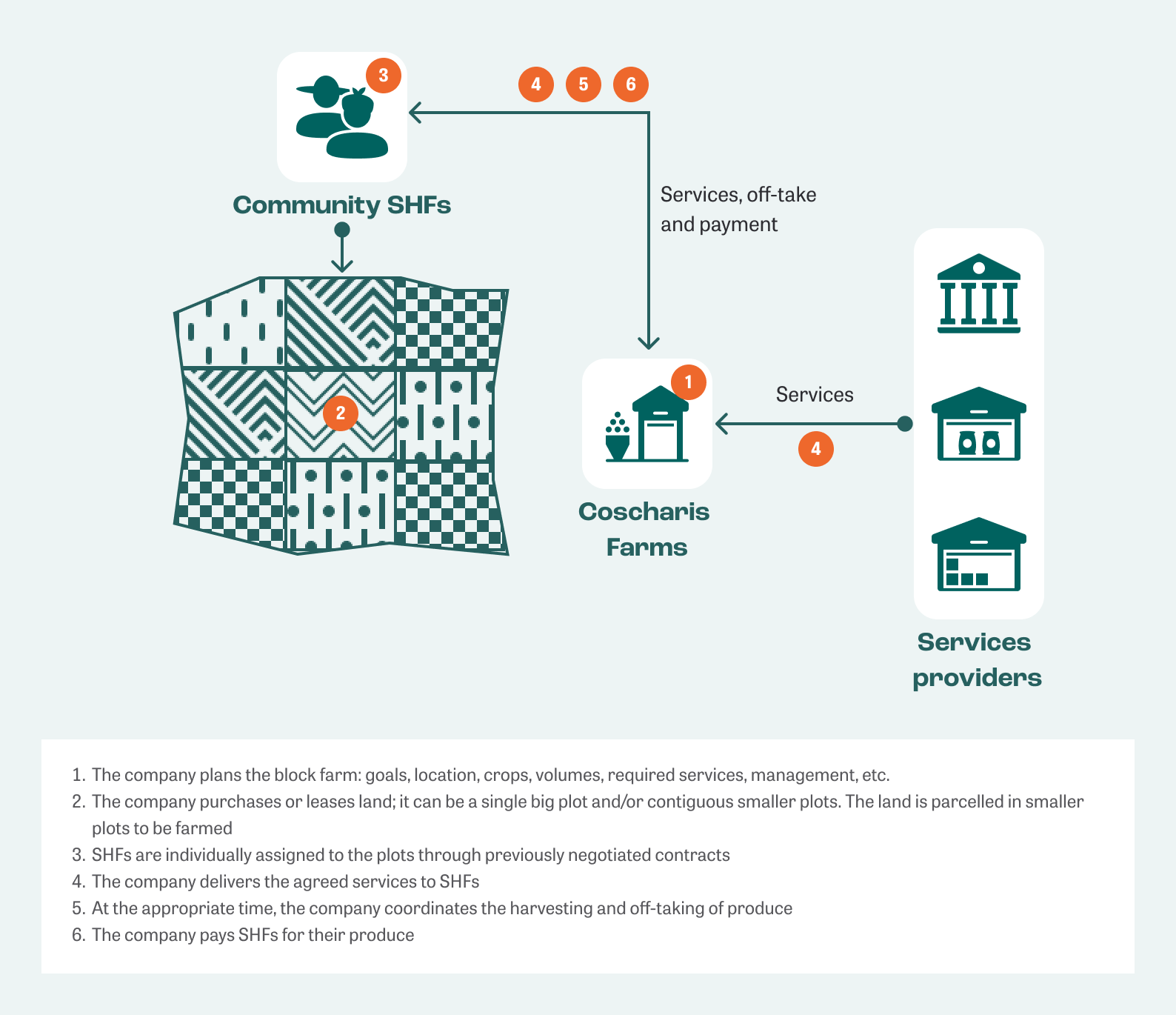Block Farming: A new Farming Approach to Improve the Performance of Companies and Smallholder Farmers
What is the Innovation?
Block farming is a model that works by parcelling a single contiguous large area of agricultural land (i.e., the block farm) into smaller plots. Smallholder farmers (SHFs) farm individual plots within this larger area, thereby emulating the dynamics of a large farm. The block farm is typically overseen by a company, which provides SHFs with the required goods and services at scale. These may include inputs, mechanization, training, financing, and a guaranteed market. The company either owns or leases the land and allocate it to farmers for a specified period. Other similar models are those of cluster farming and mosaic agriculture.
Key Challenges Addressed
Aiming to expand its rice processing operations, Coscharis Farms Ltd. (Coscharis) started sourcing paddy rice from SHFs in 2020, expecting to source up to 23,000 MT/y from 5000 SHFs by 2024. Engaging such a big network of SHFs has posed several challenges to Coscharis. SHFs’s full potential is restricted by limited access to agricultural services. The quality of aggregated produce may be inconsistent because of SHFs’ lack of required knowledge, skills, and/or storage facilities and technologies. Some services that increase farming productivity (e.g., mechanization, irrigation) are not available and/or affordable for SHFs due to their small scale. To tackle these challenges, Coscharis has engaged in a block farming model. First, through this model Coscharis can deliver better and more affordable services to SHFs due to economies of scale. Second, SHFs produce higher-quality paddy rice due to consistent access to those services in the block farm. Third, it guarantees SHFs a market with fair prices. Lastly, by having more control over the farming process, companies meet more consistently target volumes and quality standards.
How it Works

Tips for Replication
Context
- Block farquantitiesms work best with high-yield crops, easily produced in large (e.g., cereals, root crops)
- Large areas of farmlands must be available and accessible
- Services must be available in required volumes and periods
Best Practices
- Involve communities and farmers during the planning, implementation, and operation of the block farm
- Secure required capital and service providers as early as possible during the planning phase
- Involve key organizations (e.g., church, schools, etc.) and people (e.g., village heads) while negotiating land and mobilizing farmers
- Conduct due diligence on lands’ legal status before closing any agreement to prevent litigation risks
- Establish formal relationships with SHFs through fair contracts; include off-taking clauses to guarantee a market to them
- Establish a robust decision-making structure for an effective management of the block farm
Enabling Conditions
- The company must be committed to work with this farming model
- The company must have strong leadership to coordinate activities
- Required resources and staff for the block farm must be secured
- SHFs must be used to/open to working in coordination, and willing to collaborate and learn new practices
Business Case
(Expected) Outcomes for Coscharis Farms Ltd.
Better procurement
By means of the block farming model, Coscharis have increased its paddy rice supply by 9%. At the same time, due to the effective delivery of services (e.g., training, inputs, mechanization, etc.), Coscharis has reduced its rice rejection rate from 40% to 5%.
Enhanced social responsibility
Through its block farm, Coscharis has bolstered its social responsibility. In the last 3 years, the company has invested $12.1 million in the communities of influence and created 20 new jobs in the area. The company has incorporated 1740 women in the block farm (33% of total block farmers). Moreover, the total paddy rice sourced from SHFs has increased from 16% to 52%.
Impact Case
(Expected) Outcomes for smallholder farmers
Increased productivity
By having secured access to better services (e.g., training, seeds, fertilizers, mechanization, etc.), SHFs partaking in the block farm have experienced an increase in their productivity of 75%.
Increase income
SHFs in the block farm (as outgrowers) have seen an increase in their income by 103%. This substantial increase have been possible due to an increase in productivity and to the guaranteed market within the block farming model.
Reduced cost of services
SHFs in the block farming model pay lower rates of services as compared to acquiring them in isolation. Due to this increased access and affordability, in the last 3 years women and men block farmers adopting several services (e.g., irrigation, land preparation, improved seeds, crop insurance) increased by 315%, and 330%, respectively.
Outstanding Risks and Challenges
- SHFs may not trust each other enough as to collaborate effectively in the block farm, especially if they come from communities with conflicts and rivalries
- Securing capital and service providers early in the season can be challenging. If these resources are not available, block farming may turn unfeasible
- Some SHFs may encounter challenges in cooperating (i.e., following instructions from block farm managers) due to their individualistic nature. This could lead to farmer dissatisfaction and potential conflicts with the company
- The block farm can create conflicts between block- and non-block farmers due to jealousy and antagonism
- By intensely monocropping, block farms can face environmental risks like soil depletion, gradual lower productivity, and increased risks of pests and diseases
Data Sources & Disclaimer
Information is based on IDH’s Service Delivery Model (SDM) analysis for Coscharis, including data from Coscharis and 408 farmers (information is available on our methodology for SDM Analyses and Farmer Surveys). Additionally, interviews with company, officers, and farmers have been heldsince the start of Technical Assistance (2020) during which the innovation is tested and scaled. A longer time span and additional data are needed to verify and quantify impacts. Farmfit will conduct an end-line assessment of the company’s SDM and farmer livelihoods based on a repeat data collection at company and farm level.
Related Resources


Your Insights Hub journey has just started
Sign up here for access to updates - and industry insights and innovation - from the Smallholder Inclusive Business Newsletter.